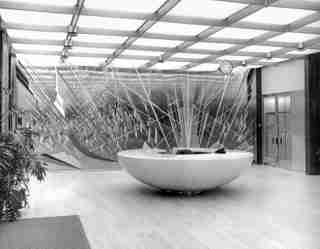Today, Eero Saarinen is one of the world’s most famous architects, noted for such designs as the TWA Flight Center at New York’s John F. Kennedy International Airport, the Gateway Arch in St. Louis, and Washington Dulles International Airport in Washington, D.C. (not to mention his iconic womb and tulip chairs). But well before stepping into the spotlight with these projects, he was more commonly known as the son of Finnish architect Eliel Saarinen, a pioneering figure in design during the first half of the 20th century, at whose firm he worked for years. The younger Saarinen didn’t develop his own identity until his first solo project, the General Motors Technical Center, in Warren, Michigan. That building and its design legacy as a midcentury-modern icon are the subjects of the new book Where Today Meets Tomorrow: Eero Saarinen and the General Motors Technical Center ( $60, Princeton Architectural Press ) by General Motors designer Susan Skarsgard.
“When I first started working at GM, designing emblems and nameplates for cars and trucks, I was so fascinated and inspired by the overall design aesthetic of the buildings and furnishings throughout the campus,” says Skarsgard. “That said, I really knew nothing about the midcentury design world and how Michigan played such an important role as a nexus for design practitioners and manufacturers of the time.”
Skarsgard was tasked with creating a one-of-a-kind book for the GMTC’s 50th anniversary in 2006, which allowed her to dig deep into the design history of the campus. Her research was so robust that she ended up founding the GM Design Archive & Special Collections, which was ultimately responsible for the site’s designation as a National Historic Landmark in 2014. It also led to the creation of Where Today Meets Tomorrow —here, take a peek inside the book’s pages.

This photograph of the styling building and the adjacent fountain was taken in 1963, just seven years after the campus opened.

Behind the “teacup” desk in the lobby of the styling administration building is the artwork Lines in Motion, by Buell Mullen.

The lobby of the process development administration building features glass curtain walls, rectilinear furniture, and reflective surfaces—all demonstrating the technical prowess of GM.
The campus featured furniture by some of Saarinen’s great contemporaries, such as Finn Juhl, who crafted this chair found in GM head of design Harley Earl’s office. It was upholstered in fabric by Alexander Girard.
Saarinen put dramatic staircases in the lobbies of his buildings—this one in the research administration building was inspired by Vladimir Tatlin’s Monument to the Third International and Oscar Niemeyer and Lúcio Costa’s Brazil pavilion at the 1939 New York World’s Fair.
Curved lines abound inside the styling building’s color studio.
Between the 1956 GM XP-500 experimental vehicle in the foreground and the stainless steel water tower in the background, this photo, though taken in the 1960s, looks incredibly futuristic.
Where Today Meets Tomorrow: Eero Saarinen and the General Motors Technical Center, by Susan Skarsgard.
